NCERT Solutions For Class 3 Maths Chapter 12 - Can We Share
Can We Share deals with readiness for division through the concepts of equal sharing and grouping. This chapter have exercises on equal sharing, grouping, relating division with multiplication. The solutions for Math-Magic Chapter-12 have been created and verified by our experienced subject matter experts, according to the CBSE syllabus and guidelines of NCERT. For practice, our subject matter experts have created very interactive, activity-based, and Image-based worksheets on these topics to enhance learning. The NCERT Solutions of Math-Magic for Class-3, Chapter-12: Can We Share in PDF format can be downloaded for free Click Here.
Download PDF For NCERT Solutions for Maths Can We Share?
The NCERT Solutions For Class 3 Maths Chapter 12 - Can We Share are tailored to help the students master the concepts that are key to success in their classrooms. The solutions given in the PDF are developed by experts and correlate with the CBSE syllabus of 2023-2024. These solutions provide thorough explanations with a step-by-step approach to solving problems. Students can easily get a hold of the subject and learn the basics with a deeper understanding. Additionally, they can practice better, be confident, and perform well in their examinations with the support of this PDF.
Download PDF
Access Answers to NCERT Solutions For Class 3 Maths Chapter 12 - Can We Share
Students can access the NCERT Solutions For Class 3 Maths Chapter 12 - Can We Share. Curated by experts according to the CBSE syllabus for 2023–2024, these step-by-step solutions make Maths much easier to understand and learn for the students. These solutions can be used in practice by students to attain skills in solving problems, reinforce important learning objectives, and be well-prepared for tests.
How Many in Each Group?
Draw 18 stars. Put them into 2 equal groups.

If 18 stars are put into two equal groups, there will be 9 stars in each group. The correct answer is:

There are _______ laddoos.
They are in ______groups.
There are __________ laddoos in each group.

Observe the given picture and count the number of laddoos, number of laddoos in each plate, and number of plates. The correct answers are:
There are 12 ladoos.
They are in 4 groups.
There are 3 laddoos in each group.
Draw 18 beads. Put them into 3 equal groups.
There are _______beads in each group.
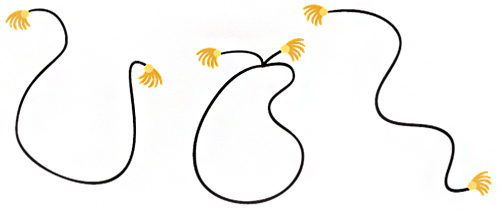
If 18 beads are divided in 3 equal groups, there will be 6 beads in each group.
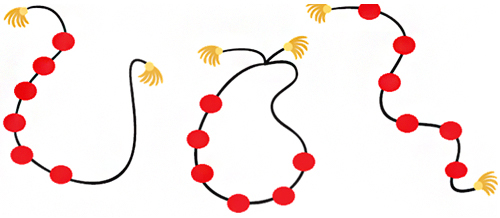
There are_______ caterpillars.
They are in_______ groups.
There are_______ caterpillars in each group.
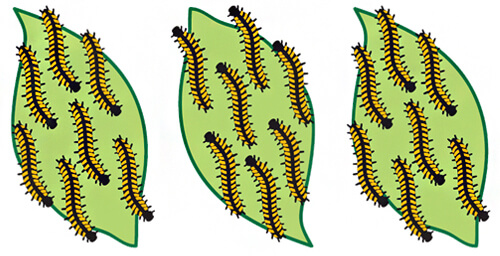
Observe the given picture and count the number of caterpillars. The correct answers are:
There are 21 caterpillars.
They are in 3 groups.
There are 7 caterpillars in each group.
Share the Grains

Mummy bird brings 12 grains.
How to distribute equally?
Mummy bird starts by giving 1 grain to each baby.
Then Mummy bird gives one more grain to each baby.
Each baby has got 2 grains now. How many grains are left?
There are 6 baby birds and each bird has got 2 grains.
So, the baby birds have got a total of
2 + 2 + 2 + 2 = 8 grains
Since the mummy bird had 12 grains, subtract 8 from 12 to get the number of grains left with the mummy bird.
12 – 8 = 4
Therefore, 4 grains are left.
Try These Now.......
Gopu has 3 plates of jalebis.
Each plate has a different number of jalebis.
Now draw the jalebis on the plates below, so that each plate has the same number of jalebis.
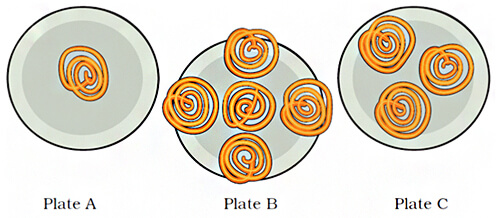
Observe the given picture, there are 9 jalebis in all. To share 9 in 3 equal groups, divide 9 by 3.
9 ÷ 3 = 3
Therefore, there will be 3 jalebis in each plate.
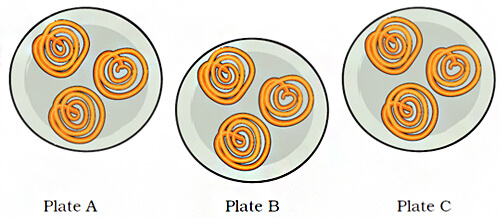
Whose Jug Holds More?
Hari Prashad has 30 metres of rope. He distributes it equally among his three children.
Each child gets _______ metres of rope.
Hari Prashad has 30 metres of rope. He distributes it equally among his three children.
Each child gets _______ metres of rope.
If there is 36 metres of rope, how much of rope will each child get?
To distribute 36 equally among 3 children, divide 36 by 3.
36 ÷ 3 = 12
Therefore, each child will get 12 metres of rope
If there is 60 metres of rope, how much will each child get?
To distribute 60 equally among 3 children, divide 60 by 3.
60 ÷ 3 = 20
Therefore, each child will get 20 metres.
If there are 28 buttons, and the tailor puts 7 buttons on each shirt, there will be_________ shirts with buttons.
28 ÷ 7 =
To find the total number of shirts, divide 28 by 7.
28 ÷ 7 = 4
Therefore, there will be a total of 4 shirts with 7 buttons on each.
How many jalebis are there altogether?
How many jalebis are there in each plate?
Discuss in the class how you found the answer.
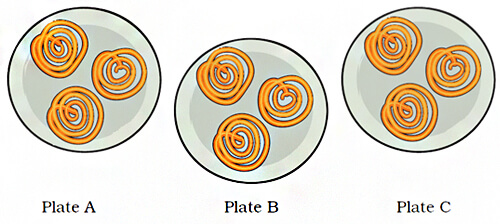
There are altogether 3 + 3 + 3 = 9 jalebis.
Each plate has 3 jalebis.
Do it yourself.
If there are 60 bananas and two monkeys, how many will each monkey get?
There are 60 bananas and 2 monkeys, then each one will get
60 ÷ 2 = 30
Hence, each monkey will get 30 bananas.
What if there are 600 bananas and two monkeys?
There are 600 bananas and two monkeys, then each one will get
600 ÷ 2 = 300
Hence, each monkey will get 300 bananas.
If there are 16 ten-rupee notes and four friends to share, then
16 ÷ 4 =_______and 4 × 10 = 40
So, each friend gets __________rupees.
Divide 16 by 4 to get the share of each friend.
16 ÷ 4 = 4
So, each one will get 4 ten-rupee notes.
Multiply 4 by 10 to get the shared amount.
4 × 10 = 40
Therefore, each friend gets 4 × 10 = 40 rupees.
Five friends found Rs 100. If they share it equally, how much will Each friend get?
Five friends have found Rs 100 and they share it equally.
So, each one will get 100 ÷ 5 = 20
Hence, each friend will get Rs 20.
Practice Time
How many laddoos will there be in each box?
There will be__________ laddoos in each box.
15 ÷ 5 =
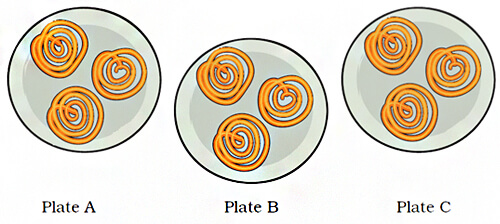
Observe the given picture. To distribute 15 laddoos in 5 boxes, divide 15 by 5.
15 ÷ 5 = 3
Hence, there will be 3 laddoos in each box.
If she uses only 3 boxes, how many laddoos will there be in each box?
There will be__________ laddoos in each box.
_________ ÷ 3 = ________
To distribute 15 laddoos in 3 boxes, divide 15 by 3.
15 ÷ 3 = 5
Hence, there will be 5 laddoos in each box.
Share 25 bananas among 5 monkeys. How many bananas for each monkey?
___________÷ 5 = _________
Each monkey has _______ bananas.
To distribute 25 bananas among 5 monkeys, divide 25 by 5.
25 ÷ 5 = 5
Hence, each monkey will get 5 bananas.
Share 12 balloons among 3 boys. How many balloons for each boy?
_______ ÷________ = _______
Each boy has___________ balloons.
To distribute 12 balloons among 3 boys, divide 12 by 3.
12 ÷ 3 = 4
Therefore, each boy will get 4 balloons.
There are 21 candles. Put them equally in 3 boxes. How many candles are there in each box?
________÷ ________ = ________
To find the number of candles in each box, divide 21 by 3.
21 ÷ 3 = 7
Therefore, each box will have 7 candles.
There are 18 socks. How many girls can wear these socks?
A person requires 2 socks. To find the total number of girls, divide 18 by 2.
18 ÷ 2 = 9
Therefore, 9 girls can wear the 18 socks.
Raj has 36 minutes to make Rotis. One roti takes 3 minutes. How many rotis can he make in this time?
He can make____________ rotis.
Since one roti takes 3 minutes, to find the total number of rotis made in 36 minutes divide 36 by 3.
36 ÷ 3 = 12
Therefore, he can make 12 rotis in 36 minutes.
These are 24 footmarks of goats. So how many goats were there?

A goat has four feet. Since there are 24 footmarks, to find the number of goats divide 24 by 4.
24 ÷ 4 =16
Therefore, there were 6 goats.
Some girls are playing a game with both their hands. The girls who are playing have 60 fingers altogether. How many girls are playing this game?
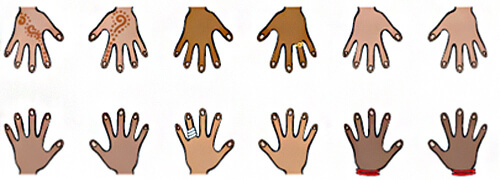
One girl has 10 fingers in her hands. Since there are a total of 60 fingers in the given image, divide 60 by 10 to find the total number of girls.
60 ÷ 10 = 6
Therefore, 6 girls are playing the game.
Lakshmi has 27 kg potatoes to sell. Three men came and bought equal amounts of potatoes.
Each man bought________ kg of potatoes.
To find the amount of potatoes each man bought, divide 27 by 3.
27 ÷ 3 = 9
Therefore, each man bought 9 kg of potatoes.
Jumpy Animals
A frog jumps 2 steps at a time.
A squirrel jumps 3 steps.
A rabbit jumps 5 steps.
A horse jumps 15 steps.
A kangaroo jumps 30 steps.
a) In how many jumps will the frog reach 30?
30 ÷ 2 =
b) In how many jumps will the squirrel reach 27?
27 ÷ 3 =
c) Which number will the kangaroo reach in two jumps?
d) Who all will meet at the number 15?
e) Will the rabbit ever be at the number 18?
f) How many jumps of the rabbit equal one jump of the horse?
g) How many jumps of the horse equals two jumps of the kangaroo?
h) Which is the smallest number where the frog and the squirrel will meet?
a) Since the frog jumps 2 steps at a time, to find the number of jumps taken to reach 30, divide 30 by 2.
30 ÷ 2 = 15
Therefore, the frog will reach 30 in 15 jumps.
b) Since the squirrel jumps 3 steps at a time, to find the number of jumps taken to reach 27, divide 27 by 3.
27 ÷ 3 = 9
Therefore, the squirrel will take 9 jumps to reach 27.
c) Since the kangaroo jumps 30 steps at a time, to find the number of steps in 2 jumps, multiply 30 by 2.
30 × 2 = 60
Therefore, the kangaroo will reach 60 in two jumps.
d) Jumps of the squirrel are:
3, 6, 9, 12, 15, 18, 21 ….
Jumps of the rabbit are:
5, 10, 15, 20, 25, 30, 35 ….
Jumps of the horse are:
15, 30, 45, 60…
Hence, the squirrel, the horse, and the rabbit will meet at 15.
e) Jumps of the rabbit are:
5, 10, 15, 20, 25, 30, 35 ….
Therefore, the rabbit will never reach 18.
f) A horse jumps 15 steps at a time and a rabbit jumps 5 steps at a time. So, the rabbit will be at 15 in
15 ÷ 5 = 3 jumps
Hence, the rabbit’s three jumps are equal to one jump of the horse.
g) A horse jumps 15 steps at a time and a kangaroo jumps 30 steps at a time.
Two jumps of the kangaroo
30 × 2 = 60
So, to reach 60 the horse will have to jump
60 ÷ 15 = 4 jumps
Hence, the horse’s four jumps are equal to two jumps of the kangaroo.
h) Jumps of the frog are:
2, 4, 6, 8, ….
Jumps of the squirrel are:
3, 6, 9, 12, ….
The frog will meet with the squirrel at 6, which is the smallest number where they meet.
How Quick Are You?
Divide into groups of 5 using 5 times table.
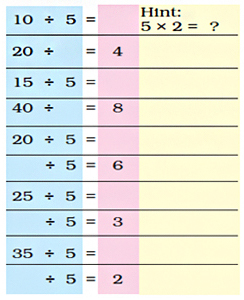
The correct answer is:
| Hint | ||
|---|---|---|
| 10 ÷ 5 = | 2 | 5 × 2 = 10 |
| 20 ÷ 5 = | 4 | 5 × 4 = 20 |
| 15 ÷ 5 = | 3 | 3 × 5 = 15 |
| 40 ÷ 5 = | 8 | 5 × 8 = 40 |
| 20 ÷ 5 = | 4 | 5 × 4 = 20 |
| 30 ÷ 5 = | 6 | 5 × 6 = 30 |
| 15 ÷ 5 = | 3 | 3 × 5 = 15 |
| 35 ÷ 5 = | 7 | 5 × 7 = 35 |
| 10 ÷ 5 = | 2 | 5 × 2 = 10 |
Try these.
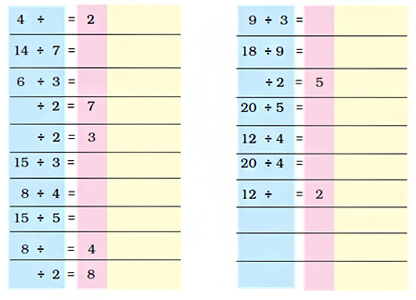
The correct answer is.
| Hint | ||
|---|---|---|
| 4 ÷ 2 = | 2 | 2 × 2 = 4 |
| 14 ÷ 7 = | 2 | 7 × 2 = 14 |
| 6 ÷ 3 = | 2 | 3 × 2 = 6 |
| 14 ÷ 2 = | 7 | 2 × 7 = 14 |
| 6 ÷ 2 = | 3 | 2 × 3 = 6 |
| 15 ÷ 3 = | 5 | 3 × 5 = 15 |
| 8 ÷ 4 = | 2 | 4 × 2 = 8 |
| 15 ÷ 5 = | 3 | 5 × 3 = 15 |
| 8 ÷ 2 = | 4 | 2 × 4 = 8 |
| 16 ÷ 2 = | 8 | 2 × 8 = 16 |
| Hint | ||
|---|---|---|
| 9 ÷ 3 = | 3 | 3 × 3 = 9 |
| 18 ÷ 9 = | 2 | 9 × 2 = 18 |
| 10 ÷ 2 = | 5 | 2 × 5 = 10 |
| 20 ÷ 5 = | 4 | 5 × 4 = 20 |
| 12 ÷ 4 = | 3 | 4 × 3 = 12 |
| 20 ÷ 4 = | 5 | 4 × 5 = 20 |
| 12 ÷ 6 = | 2 | 6 × 2 = 12 |
| 15 ÷ 5 = | 3 | 5 × 3 = 15 |
| 8 ÷ 2 = | 4 | 2 × 4 = 8 |
| 16 ÷ 2 = | 8 | 2 × 8 = 16 |
Divide into groups of 2 using 2 times table.
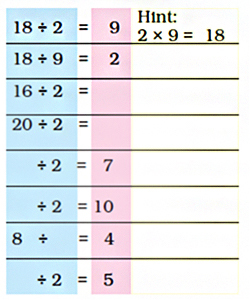
The correct answer is.
| Hint | ||
|---|---|---|
| 18 ÷ 2 = | 9 | 2 × 9 = 18 |
| 18 ÷ 9 = | 2 | 9 × 2 = 18 |
| 16 ÷ 2 = | 8 | 2 × 8 = 16 |
| 20 ÷ 2 = | 10 | 2 × 10 = 20 |
| 14 ÷ 2 = | 7 | 2 × 7 = 14 |
| 20 ÷ 2 = | 10 | 2 × 10 =20 |
| 8 ÷ 2 = | 4 | 2 × 4 = 8 |
| 10 ÷ 2 = | 5 | 2 × 5 = 10 |
Divide into groups of 10 using 10 times table.
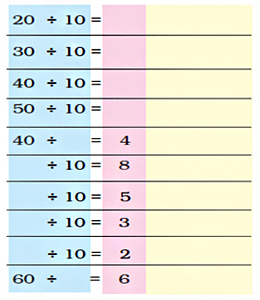
The correct answer is.
| Hint | ||
|---|---|---|
| 20 ÷ 10 = | 2 | 10 × 2 = 20 |
| 30 ÷ 10 = | 3 | 10 × 3 = 30 |
| 40 ÷ 10 = | 4 | 10 × 4 = 40 |
| 50 ÷ 10 = | 5 | 10 × 5 = 50 |
| 40 ÷ 10 = | 4 | 10 × 4 = 40 |
| 80 ÷ 10 = | 8 | 10 × 8 = 80 |
| 50 ÷ 10 = | 5 | 10 × 5 = 50 |
| 30 ÷ 10 = | 3 | 10 × 3 = 30 |
| 20 ÷ 10 = | 2 | 10 × 2 = 20 |
| 60 ÷ 10 = | 6 | 10 × 6 = 60 |
Puzzle
Divide the clock face into three parts so that the sum of the numbers in each part is the same.
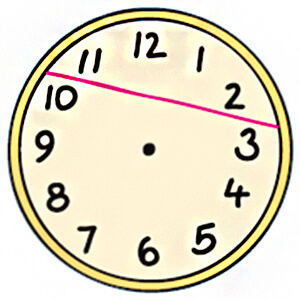
Since 11 + 12 + 1 + 2 = 26
Also 10 + 9 + 3 + 4 = 26
and 8 + 7 + 6 + 5 = 26
Therefore, the correct answer is:
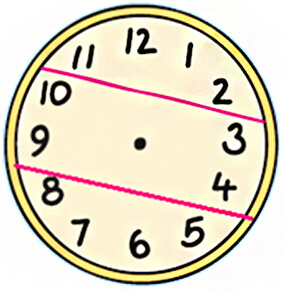
Frequently Asked Questions
The NCERT solution for Class 3 Chapter 12: Can We Share is important as it provides a structured approach to learning, ensuring that students develop a strong understanding of foundational concepts early in their academic journey. By mastering these basics, students can build confidence and readiness for tackling more difficult concepts in their further education.
Yes, the NCERT solution for Class 3 Chapter 12: Can We Share is quite useful for students in preparing for their exams. The solutions are simple, clear, and concise allowing students to understand them better. Can We Share additionally, they can solve the practice questions and exercises that allow them to get exam-ready in no Can We Share.
You can get all the NCERT solutions for Class 3 Maths Chapter 12 from the official website of the Orchids International School. These solutions are tailored by subject matter experts and are very easy to understand.
Yes, students must practice all the questions provided in the NCERT solution for Class 3 Maths Chapter 12: Can We Share as it will help them gain a comprehensive understanding of the concept, identify their weak areas, and strengthen their preparation.
Students can utilize the NCERT solution for Class 3 Maths Chapter 12 by practicing the solutions regularly. Solve the exercises and practice questions given in the solution.

